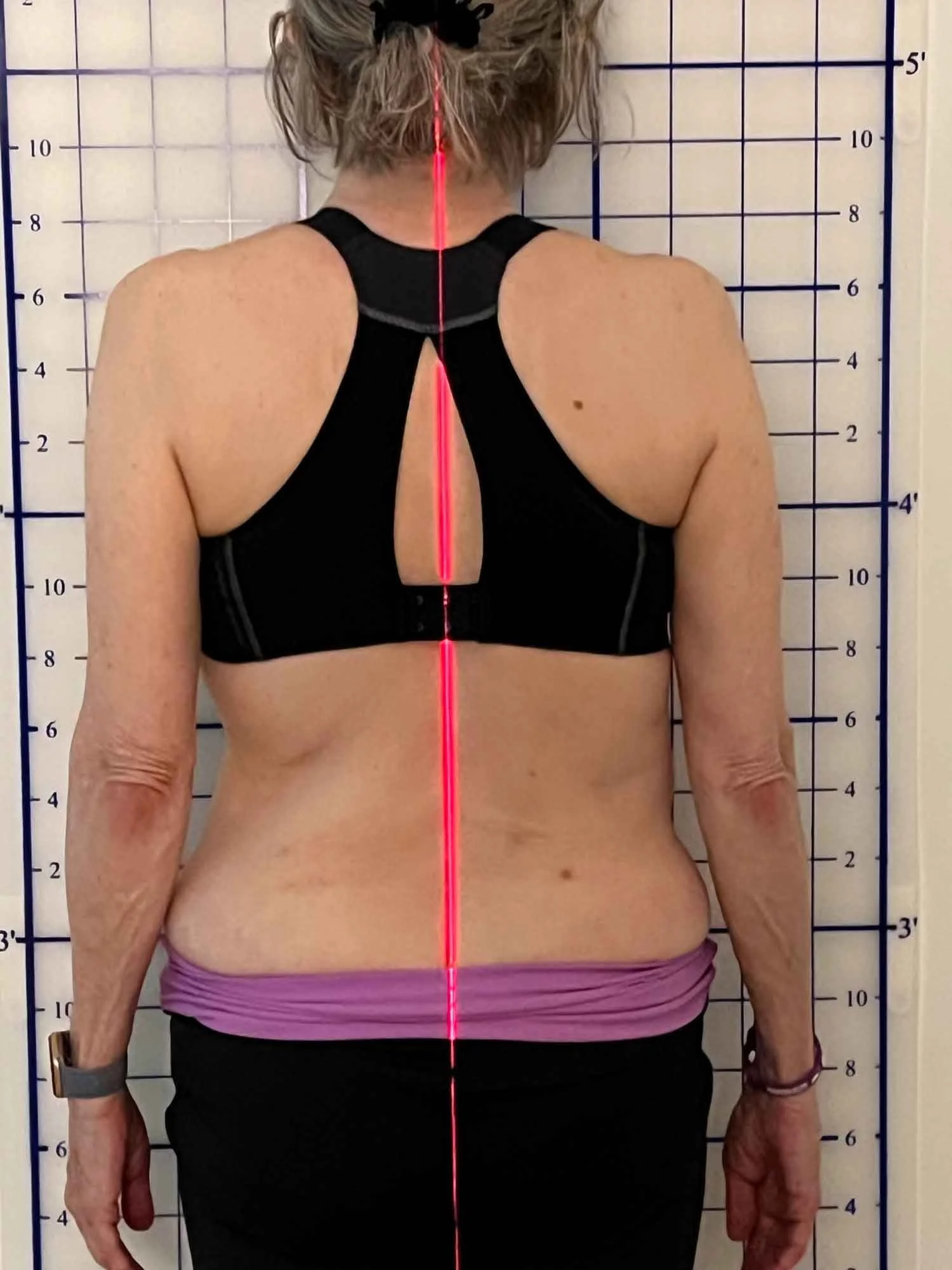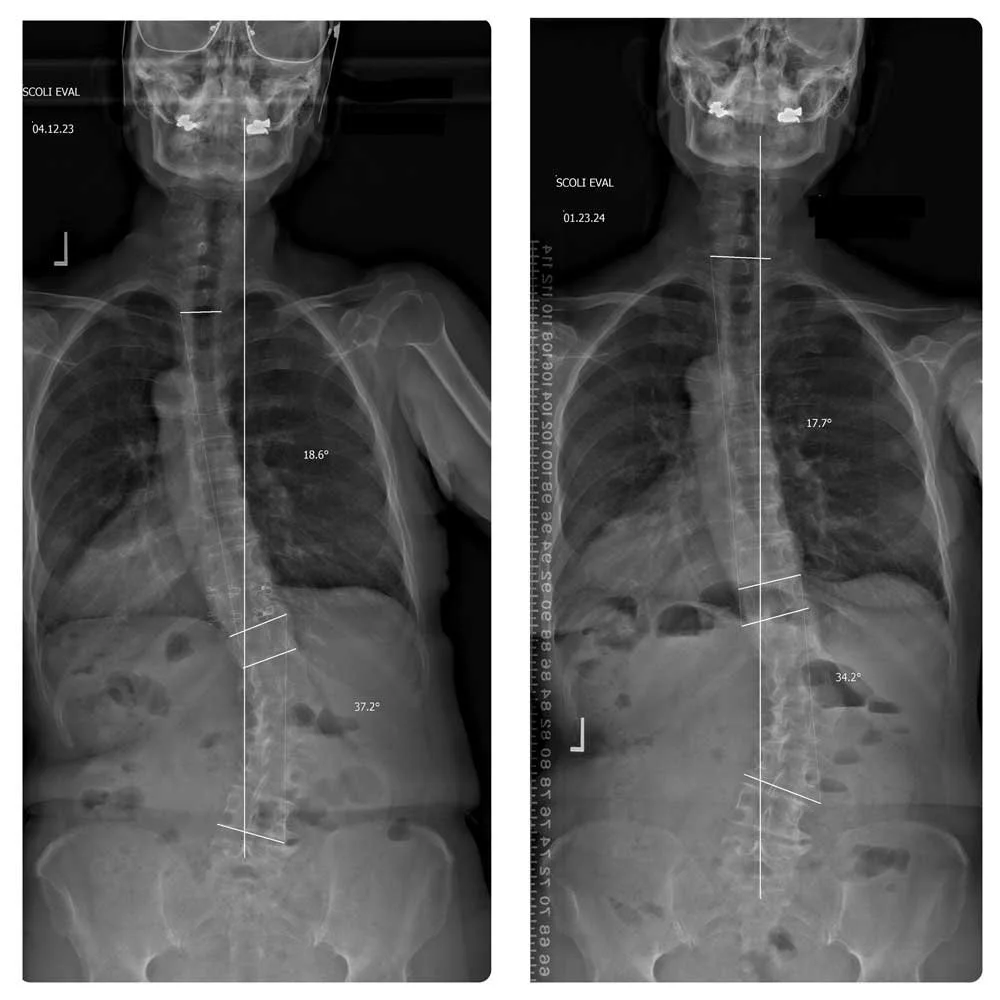Torso Re-Shaping: Adult Edition
If you follow our blogs, you’ve heard me admit time and time again adult scoliosis cannot be “corrected” nearly as well as adolescent scoliosis, if at all. It’s the bad news I hate delivering, but transparency, up-frontness regarding expectations of treatment, and evidenced-based practice are core to our mission at SchrothDC. We abide by a moral and ethical code as healthcare practitioners. We aren’t trying to sell anyone snake oil.
So when we work with adults who are profoundly “correcting” their posture and re-shaping their torsos, like the case we will discuss today, we are metaphorically jumping up and down with joy. Because, like so often happens in medicine, even if the research isn’t holding up, the anecdotal evidence can be powerful.
Anecdotal information, in the absence of hard evidence, can be helpful
Case in point: our 3-month-old baby, Cairo, went through a period about a month ago I deemed “Restless Baby Syndrome.” Between the hours of 12 and 7am (!!), he would squirm his head off, kicking, fighting his swaddle, and grunting. He seemed possessed. After a few weeks of this and lots of lost sleep, I reached out to my mom’s network to pick their brains.
The many responses I received boiled down to one thing: it’s gas. His immature digestive system, lying on his back all night, and his lack of core strength to push out that gas – were creating this exhausting physical response. AND like many of their babies, he may be sensitive to the dairy that I was eating.
Happy Baby Cairo Smiling
I hadn’t wanted to deprive myself of anything up to this point, having gone through pregnancy, delivery, recovery, and not to mention the extreme hunger from breastfeeding. But I was desperate. I cut out the dairy from my diet, and true to the words of those smart mamas I reached out to, about a week later, Cairo’s little body calmed down at night.
I checked in with the pediatrician right around this time and told her what was going on. Her exact words were: “The research on babies having dairy allergy is weak, but mothers all over the world will tell you that their [breastfed] babies are much more comfortable when mama isn’t eating dairy.” This anecdotal information, in the absence of hard evidence, was extremely helpful.
Adult Scoliosis
Back to adult scoliosis. The research regarding the effect of physiotherapeutic scoliosis-specific exercise (e.g. The Schroth Method) on adult scoliosis is weak.
Adult spines are stiffer than their adolescent counterparts. They aren’t nearly as malleable and moldable. Most, if not all, spinal surgeons will tell you that you can’t change an adult’s scoliosis through exercise. We never promise an adult that Schroth will reshape their torso.
Enter Barbara, our poster-gal for the Schroth method for adult scoliosis. Barbara started Schroth with us exactly a year ago (November 2022). She is in her 7th decade of life – an age in which most surgeons would throw up their hands and say, “Nothing you can do, just live with it.”
She came in with a posture very affected by her right-sided lumbar scoliosis. As her lumbar spine had shifted to the right, her torso was collapsing to the left. (If you’re a Schroth-trained therapist reading this, this is known as convexity mal-alignment).
As you can see in her intake photos, the left side of her torso is collapsed, her pelvis is shifted to the right (right pelvis and right arm are bumping into one another), and her head isn’t centered on her pelvis: it’s shifted to the left.
Barbara’s Resting Posture Upon Intake November 2022
I know many of you will look at these photos and say, “How does she not know she is leaning over?”. She had no idea. If you remember our blog from June 2022, The Vestibular System and Scoliosis, people with scoliosis have altered vestibular systems, part of the central nervous system that regulates posture.
Barbara’s brain had adapted to her scoliosis and to her subsequent scoliotic posture – maybe a better way of saying this is that as Barbara’s spine became scoliotic, her muscles and ligaments failed to compensate for her bent spine.
If they had compensated (which is what we teach you to do via Schroth), she would not have ended up leaning over. The posture you see in her intake picture felt absolutely “normal” and “straight” to her. Thus, the reason we take and share pictures of the spine with patients on day 1 of Schroth treatment. Visuals are powerful.
We always ask patients what their goals are for coming to Schroth therapy. In Barbara’s case, she wanted to learn how to safely strength train to get stronger and to stabilize her scoliosis to prevent worsening. She was already getting lots of cardiovascular exercise via walking and stationary biking most days per week when she started Schroth.
However, she was not doing any strength training due to fear of hurting her back. This is an extremely common fear in folks with scoliosis. The clinical term is kinesiophobia: “fear of movement.”
What’s ironic is that people living with scoliosis should absolutely be doing strength training; it’s integral to successfully managing the condition over the lifespan.
I’ve said it before, and I’ll say it again: you’ll get as much out of Schroth as you put into it. In Barbara’s case, she jumped in feet first. She was ready to get better. She committed to 5 days per week of Schroth exercises for 20–30 minutes. She faithfully attended her Schroth appointments with us every week to learn and perfect the exercises.
After 6 months of this intensive approach, we re-evaluated Barbara. Needless to say, we were blown away by her progress. Barbara’s posture at rest had changed in all the best ways. She no longer demonstrated the dreaded “scoliotic posture.” Her muscles and fascia had come back to life to support her scoliotic spine. Her vestibular system had been re-programmed! This is pure gold to a Schroth therapist.
Let’s take a look at her re-assessment photo from May 2023.
Barbara’s Resting Posture Reassessment May 2023
Note her head being almost perfectly centered with the center of her pelvis. Her pelvis is perfectly centered between her arms. The left side of her torso is much less collapsed. We were thrilled and a little floored, if we’re being honest.
I would have been happy with her 6-month progress, called it a victory, and possibly even hung up my hat on her case. But here’s the best news: Barbara kept at it, and her torso re-shaping got even better.
We re-evaluated her at the 9-month mark, and wow, does a picture speak 1,000 words.
Barbara’s Resting Posture Reassessment August 2023
Level shoulders. Perfect head-pelvis alignment. Left-right torso symmetry. Barely a crease in the left flank that was so profoundly collapsed when she started this process 9 months earlier. Cue the standing ovation.
Barbara inspires us as therapists, and we hope she inspires you if you’re living with adult scoliosis. We want you all to “be a Barbara.” Put in the hard work. Stick with it. Keep learning. Your spine and torso depend on it.
Lastly, we love a good side-by-side reel at SchrothDC. Here’s the money shot. Barbara, in 3 acts…
Barbara’s Resting Posture November 2022 v. May 2023 v. August 2023
Update: April 2024
Barbara had her annual x-rays taken, and we felt compelled to share. Her sagittal plane x-rays, meaning her spine from the side/profile view, have greatly improved: her thoracic kyphosis (how much the upper and mid back round forward) was 49.5 degrees last year, 2023. In 2024, her thoracic kyphosis is 30.3 degrees - that’s almost 20 degrees of less hunching (!!) This is a big, big deal: scoliosis often leads to kyphosis, and increased kyphosis can greatly affect balance and walking ability. Also, it’s exhausting for your spinal muscles to “hold up” a kyphotic spine.
Taking a look at her x-rays in the frontal plane, we see that the Cobb Angles of her scoliotic curves have not meaningfully changed (“meaningful change” means a change of 5 degrees). We would say her scoliosis is stable, which is a victory for adult scoliosis. This is important because although her degree of scoliosis on x-ray has moreless remained the same, her torso looks much, much different from the outside. This is the essence of torso re-shaping in the adult body: getting the muscles along the spine to be symmetrically strong to support the scoliosis.
One last victory from the frontal plane x-rays. Look at the white vertical line in the center of the x-ray: this is called the Central Sacral Line (CSL). The CSL originates in the center of the sacrum, the triangular bone at the base of the spine. The more the center of the neck and face lines up with the center of the sacrum, the better. In 2023, Barbara’s CSL was quite far from the center of the neck/face; in 2024, it appears much more aligned. The technical term for this is Coronal Balance, and it is one of the data points scoliosis surgeons assess in their decision-making process about who needs surgery. Bottom-line: the closer the center of your sacrum lines up with the center of your neck, the better the prognosis for your scoliosis. The inverse of that statement is also true.
Well done, Barbara.







